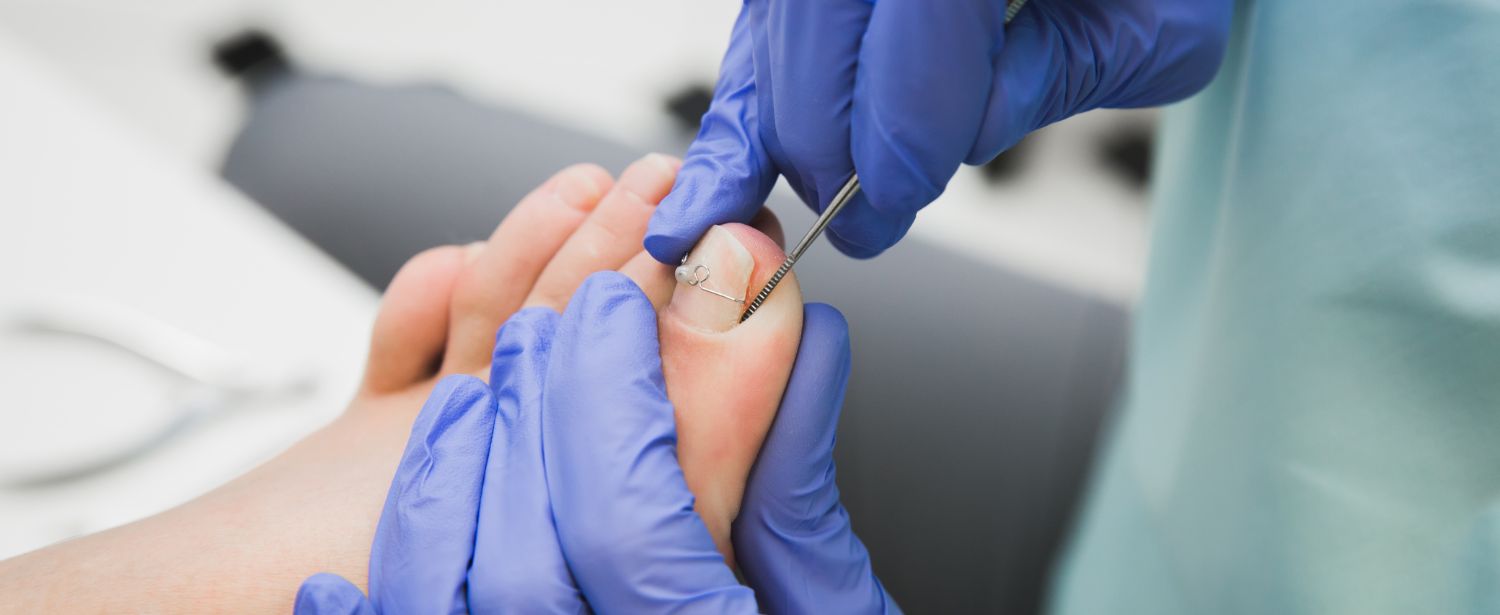
Overview: Ingrown Toenails
An ingrown toenail is a common and painful condition that occurs when the corner or side of a toenail grows into the soft flesh of the toe. It usually affects the big toe. This results in pain, inflamed skin, swelling, and can also lead to infection around the toenail. If you experience these ingrown toenails symptoms, it is important to seek proper professional help for the treatment of ingrown toenails without delay. Foot specialists can take steps to relieve your severe or spreading pain, and help avoid further complications. Those who have diabetes or any other condition that causes poor blood flow to the feet are at greater risk of complications of ingrown toenails.
Ingrown Toenails Symptoms
An ingrown nail problem causes pain and can impact your quality of life as the toenail burrows into your skin. It can be caused by shoes, fungal infections, and improper nail clipping. Read on for some ingrown toenails symptoms:
- Pain and tenderness
- Inflamed skin
- Swelling
- Infection
Ingrown Toenail Treatment
You can soak your feet in salt water to temporarily relieve the pain. Do also trim your toenails regularly and correctly. However, it is important to deal with the main problem as untreated ingrown toenails can cause serious health issues. In serious cases, infections arising from ingrown toenails can spread to the adjoining bones and tissue. Chiropodists’ treatment is necessary to nip the problem in the bud.
After an examination of your ingrown toenails, your foot specialist will decide on the best ingrown toenails treatment option to relieve your toe discomfort and pain. The recommended course of action will depend on whether the condition is a one-off or a recurring issue, as well as its severity. The chiropodists’ treatment will be tailored to suit each individual.
Here’s a look at some of the common ingrown toenails treatment options available at Toronto chiropodists …
Elevated nails: In this chiropodists’ treatment procedure, the nail edge will be carefully lifted to separate it from the skin below. This would relieve the discomfort caused by an ingrown nail. The nail would then be covered with cotton, dental floss, or a splint to prevent it from touching the skin and to enable it to continue growing.
Partial nail removal: In some cases, the ingrown toenail infection becomes red, painful, and filled with pus. In this case, the pus needs to be drained. The ingrown portion of the nail edge, called a partial nail avulsion (pna), would be cut out. Local anaesthesia could be used to numb the toe for this procedure.
Complete nail and tissue removal: In case of persistent and recurrent ingrown toenails on one toe, the ingrown toenail may be removed along with any underlying tissue. This could be done using a chemical solution or laser.
BS Brace: This is a simple and painless alternative to toenail surgery. An adhesive is applied to the underside of the BS Brace. The BS Brace is attached by gently pressing for ten seconds on the nail. A safe sealant is applied to the nail and the BS Brace to ensure adhesion. Once the sealant has dried on the nail, the nail is secured with BS adhesive. You can then resume your normal routine with the BS Brace applied to your nail. Over the weeks that follow, the BS Brace painlessly repositions the problematic toenail and trains it to keep the proper alignment. In most cases, relief is experienced within 30 minutes itself. The BS Brace has to be changed every four weeks until the ingrown toenail emerges.
Post ingrown toenails treatment, the treated toenails must be properly cared for to speed up the healing and to avoid infection. Wash the foot wound and the skin around it. For a week, soak it regularly in a solution of Epsom salts and antimicrobial soap. Dress the nail with a cream and wrap a bandage around the toe. Wear loosely fitting shoes to reduce any pressure on the toe while it heals.
Preventive Measures
Here are a few tips to prevent an ingrown toenail and toe discomfort:
Toenails should be trimmed straight across. It is not advised to cut your nails in a curving manner to match the shape of the front of the toe. If getting a pedicure, request the person doing it to trim your nails straight across. In case you have a condition that causes poor blood flow to the feet and are unable to trim your nails, visit a podiatrist to have them trimmed regularly.
Toenails should be kept at a moderate length and not too long or too short. The length of toenails should be the same length as the tips of your toes. If you trim your toenails too short, the nails could grow into the tissue due to the pressure from your shoes on your toes.
It’s important to wear properly fitting shoes. Do not wear shoes that place extra pressure on your toes or pinch. This could cause a nail to grow into the surrounding tissue. Be aware of this as in case you have nerve damage to the feet, you may not be able to sense if your shoes are tight-fitting.
Do use protective footwear. Wearing shoes that protect your toes, such as steel-toed shoes, is recommended, if you are indulging in activities that could injure your toes.
Examine your feet. Checking your feet daily for signs of ingrown toenails symptoms or other foot problems is highly recommended; even more so if you have diabetes.
Conclusion
If you are experiencing an ingrown toenail or any other foot, ankle, lower limb skin or nail and toe discomfort, do choose trusted Toronto chiropodists and foot specialists. Contact a good clinic with a team of skilled and knowledgeable Toronto chiropodists. You will receive guidance on a range of chiropodists’ treatment options, both non-surgical as well as surgical interventions if required, for your personalised ingrown toenails treatment by foot specialists.